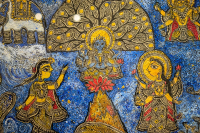Culture & Lifestyle
When will Dalit lives matter?
Despite voices being raised in the Capital and across the country against the injustices inflicted on Dalit people, their plight remains the same. The Post takes a look at the events that took shape last year and why they were not enough.
Srizu Bajracharya
Every day a number of people pass by a wheatpaste memorial drawn on one of the exterior walls of Lalitpur Engineering College in Chakupat. The memorial has eight people: Bijay Ram, Ajit Mijar, Shiva Shankar Das, Angira Pasi, Samjhana Kami, Mana Sharki, Shambhu Sada and Nawaraj BK—all of them belong to the Dalit caste, all of them were killed brutally in separate persecution incidences in rural parts of Nepal. Among them, five were killed in 2020. Their portraits in Lalitpur are engraved with the words: ‘Not Forgotten’.
The wheatpaste work was part of the project Paint the Revolution initiated by the social campaign, Dalit Lives Matter Nepal, in collaboration with Kaalo.101, an independent art collective based in Patan.
While this is happening in Lalitpur, in Rautahat, where Bijay Ram died after being brutally tortured in police custody, 25-year-old Udaya Narayan Chamar feels alienated—he does not feel part of the different efforts and social campaigns that have been raising their voice for the Dalit people’s rights and for a cultural change in the country.
“Here it feels like everyone except for us have moved on,” said Chamar, echoing the defeat he has felt for months. Chamar lives in Chamar Tole in Rajpur Municipality and is the chair of Dalit Samudayik Bikash Kendra. And since August he has been crusading for the justice of Bijaya Ram whose case is still under investigation.
“The police and the Municipality’s government officials have assured us that they are looking into the case of Bijay Ram. But nothing really has happened, and we are still awaiting his justice,” he said.
Living as a Dalit in Nepal is not easy. And the year 2020 has been particularly hard for Dalit communities. Violent incidences in Soti, Rukum, (where a 21-year old Dalit was killed along with five of his friends for wanting to marry a girl from a higher caste) and in Rupandehi (where a 12-year-old Dalit girl was found dead after being married off to the man who raped her) in the past year served as catalysts to bring together many voices, and social campaigns across the country—including celebrated Nepali actor Rajesh Hamal’s ‘Jaatko Prashna’ to question the systemic ills of the caste system. But these initiatives have not been enough to bring about a radical change.
Despite these efforts, the plight of Dalits remains the same and for many like Chamar, there is no light at the end of the tunnel.
Amid the pandemic, however, the killings of Nabaraj BK, and Angira Pasi spurred an extraordinary revolt on the internet addressing the two Dalits’ lives. Alongside the Black Lives Matter movement in the US, following African American George Flyod’s death, urban Nepalis responded to the heinous killings in the rural areas with the hashtag trails that read #Dalitlivesmatter.
For weeks, there were more than hundreds and hundreds of appeals for justice on the lives lost. And by June, the voices had taken different forms: from petitions to show solidarity to casteism conversations. In late June, Dalit Lives Matter Nepal, a social campaign, introduced ‘Caste Conversation’ with Pradip Pariyar, a social activist and executive director of Samata Foundation, to discuss and understand caste through various critical lenses.
Pariyar and his team from Dalit Lives Matter Nepal also had immediately started documenting Dalit killings’ incidences on their page as they saw a huge information gap. The campaign also introduced forms to register discrimination online and disseminated information to educate users of the platform on caste-based discrimination and the laws related to it.
In between these incidences, many youths in other parts of the country, like Rautahat and Parsa, came together to organise campaigns like Dalit Bachha Siksya ko Pahuch Tatha Vidhyalaya Tikau Abhiyaan, as a call to action programme because they believed education would be one of the most important tools to fight the structural caste-based discrimination. Many youths in Parsa were also involved in campaigns like 101 Dalit Youth Leadership that sought to build the leadership skills of Dalit youths to aware their community about their rights.
But one of the significant efforts of some social campaigns had been to see through the justice process of the Dalit killings.
“We have had about 14 Madhesi Dalit people’s death in Province 2 just this year, and that number is quite scary, but all these cases are still stalled,” said Ram.
When the vehement outcries from the public had subsided, Dalit Lives Matter Nepal was still pushing forward to investigate Nawaraj BK and Angira Pasi’ case from Kathmandu. And in Rautahat and Parsa, organisations like Peace for Dalit Foundation and Dalit Samudayik Bikash Kendra kept on pressing for the investigation of Niranjan Ram, Bijay Ram, Shambhu Sada and Samjhana Kami. At Sakhuwa Prasauni rural municipality various young Dalit groups also initiated a Dalit Dabab Samuha to address Dalit discriminations.
However, the different efforts taken by individuals, groups and organisations have not translated into any reforms in society.
While many events hoped to significantly impact the general public’s mindset for some reason there has been an absence of a meaningful change, say Dalit activists. Many events that manifested to empower Dalit voices had thought they would in some ways create ripples to change the culture of caste-based oppression. And they continue to believe their efforts will press for the rights of the Dalits in the future.
But nothing has changed, says Manoj Ram. “These voices have not spread out like we had imagined it would,” he said.
Locals in areas like his, inside Dalit toles, are well aware the government is not interested in their problems, says Ram, who lives in Mahuwan Gau, Dalit Tole in Parsa. Ram is also an activist and the chair of Peace for Dalit Foundation Nepal.
According to him, the Dalit people in the rural areas have so much hardship that awareness has not even been their primary concern.
“There haven’t been any government-led initiatives in our areas, and we are still living as outcasts; we are nowhere close to ending the horror of the Dalit people,” says Ram.
Ram is aware that Dalit discrimination is pervasive both in and outside of their castes and for things to really change, the Dalit people need to be empowered first.
“What we need is programmes that can empower our people to grow economically, initiatives that will educate them, programmes that focus in areas like ours. But the government has not even separated a budget for the Dalit people’s development; nor have funds ever reached here to help families in this dire time,” said Ram.
According to recent studies, the Dalits fall under the minorities who are the most affected in the ongoing Covid-19 pandemic; the crisis has worsened social inequalities and further pushed out the Dalit people from development.
In recent times, according to Chamar, it has been more dangerous for younger Dalit girls and boys to walk in their hometowns, he says. “There have been incidences where some non-Dalits invite the Dalits to drink, and when they get drunk, they bash them together telling they caused a nuisance. This is how we have been living here, and this is the reality of our place,” said Chamar.
“And when we try to do something for our community, press for the injustices we are told that we are trying to act like heroes, and we get threatened,” he adds.
But these recent incidents have awakened the Dalit people from within, says Ram.
“Many people in our community have learnt that we need to step up for ourselves. And so, people despite their difficulties are addressing their issues,” said Ram. “I am even ready to die to make things better for our people,” he said.
However, the government’s initiative on the overall events that started since May, according to the people the Post talked with, has been very minimal. “Many of the movements and efforts we made were conceived individually from our pockets, from the people we know and from some organisations like Samata Foundation. But the government has not really made an effort to help with our issues—we work on our own, and it has been scary for us because we don’t get any kind of protection for speaking out,” said Ram.
But over the course of the Dalit Lives Matter Nepal journey, Pariyar shares one of their key learnings to make way for an equal society has been their realisation that organisations and movements like theirs need to work together with different capabilities in multiple levels to spread the awareness and bring change structurally.
According to him, the media’s role has been the most significant to bring attention to Dalit issues, while the role of the police is something they need to work more deeply into as that is where the process for justice and accountability starts. “We have learnt that we have to work together with the police force, with the government, journalists and human rights activists if we are to work on justice and awareness,” said Pariyar.
“We have come to understand to work on multiple levels of caste-based discrimination and that we also need to create a global alliance and global solidarity to fight this system from within,” he further added.
But the major reason why little action is being seen in real-time is because everything is centred around Kathmandu. “The conversations related to caste discrimination happening in Kathmandu hardly trickle down to the areas we live in,” said Ram.
Most programmes for Dalit people are centred around Kathmandu when the most vulnerable Dalit communities are in the rural areas where the division of the Dalits and the non-Dalits are distinct, in the way they live and where, he says.
“We have families who are barely making income, and so many of these houses have no electricity, so while the focus should be on Dalit people in areas like ours, the voices are all focused at the centre. People’s conversation about caste-based-inequality is our daily reality here,” said Chamar.
“But people assume just because people are talking about these issues there, things are changing down here,” said Chamar. “For us, every day has been turning more and more unsafe. And so, even with all that is happening our people’s lives are still on the line.”
“Just a few initiatives is not enough to change the system that is entrenched in the ills of the caste system for so long.”
(Disclaimer: The article does not include all the events that happened in 2020.)




 16.2°C Kathmandu
16.2°C Kathmandu















